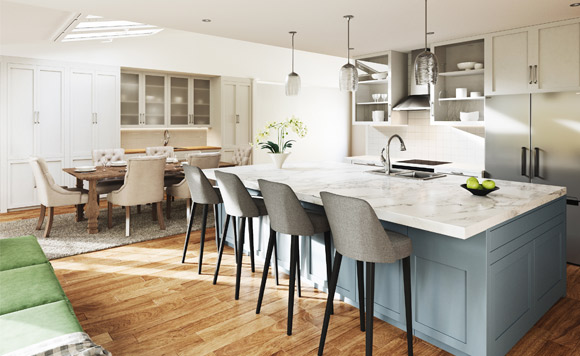by Uta Nagel, Uta Nagel Interior Design
The thought of renovating often causes anxiety and concern among homeowners and property buyers. We fear that alterations will turn into a bottomless pit, that we’ll run into unforeseen problems, or we simply have no idea where to start. Here are a few tips that make the first steps easy!
1. PLANNING. The key to a successful renovation is planning the entire process section by section. The most important question is: What elements need to be considered before you can start the changes? For example, if you remove a wall, you need to figure out if it is load bearing. If it is, you need to take special precautions to support the structure during removal. How can you tell if a wall is load bearing? Check if the wall support continues into the upper floor levels or attic; if it continues, it’s load bearing. However, before removing walls always consult a contractor.
2. THE VISION. Preparing and researching your renovation can take a long time. Creating a mood board is important! All you need is some space on a wall or a bulletin board. Start with a website like Houzz or Pinterest and pin up swatches of paint and fabric on a picture frame, in a folder or book.
3. FURNITURE STORAGE. If a room is to be completely renovated, the furniture must of course be temporarily stored in another room. If, however, only the ceiling and/or the walls are to be replaced, furniture can be pushed into the middle of the room and kept covered. If you can set up temporary living in another room you are good to go. However, moving into a rental suite is the best solution for a larger renovation.
4. FLOORPLAN. Make a simple floor plan of your existing space. Keeping the existing layout will save you money; relocating pipes and electrical is a costly undertaking, as is moving supporting walls. Before you start it’s a good idea to get an assessment from a contractor.
5. BUDGET. How much money can you spend on this renovation? This is often a difficult question to answer. Setting a budget means doing your research and getting quotes from multiple contractors, as this will give you an idea how far you can go. Consider a 20% contingency on top of the estimated renovation budget to anticipate unforeseen costs.
6. THE FAMILY MEETING. Before you start swinging the hammer, you need to have a family meeting and make sure the main players are on board. Appoint one member of the family to be the spokesperson when dealing with the contractor and interior designer to avoid miscommunication. Keep a journal of hours worked and tasks done and to be done.
7. SET UP A TIMELINE. Typically the contractor will create a timeline, but it’s important for you as the homeowner to hold them accountable. Everyone involved should know when the job needs to start and finish. Set a deadline like an open house – invite some friends and order beer and pizza for the crew. This will keep everyone on their toes.
8. IMPROVEMENTS THAT ADD VALUE. Highest on the list are basement conversions, loft conversions, converting your garage into a bedroom, adding a bathroom, creating open concept, larger windows to merge indoor with outdoor, deck extensions with outdoor kitchen, garden and curb appeal.
Have fun planning and being inspired by the process!




